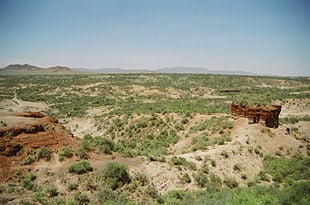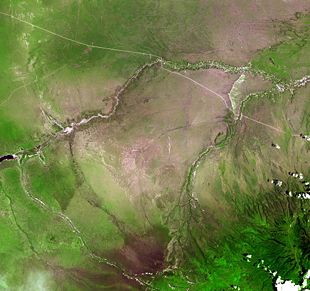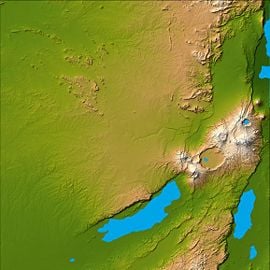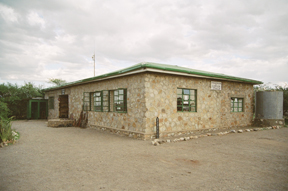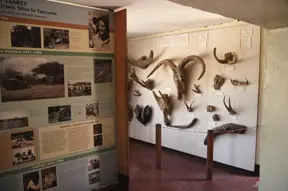Difference between revisions of "Olduvai Gorge" - New World Encyclopedia
(copied from Wikipedia) |
|||
| Line 1: | Line 1: | ||
[[Category:Politics and social sciences]] | [[Category:Politics and social sciences]] | ||
[[Category:Anthropology]] | [[Category:Anthropology]] | ||
| − | + | Tanzania is the home of the 40 kilometre-long Oldupai Gorge, the world famous palaeoanthropological site studied for more than 40 years by the Leakey family. | |
| + | Olduvai is a mispronunciation of Oldupai, the Masai word for a type of wild sisal found around the gorge. The Gorge was re-named in 2005 to correct this mistake. | ||
| + | It is located at the border of the Ngorongoro conservation area and the Serengeti National Park. Oldupai has yielded numerous fossil remains from pliocene to pleistocene times (from about five million to 10.000 years ago), including the skull of the primitive hominid australopithecus boisei or "nutcracker man," a [[species]] that became extinct about one million years ago. Despite the controversy surrounding the interpretation of many of the Oldupai specimens, scientists agree that no other site has produced stone tools, animal bones and early hominid remains so precisely associated in such a well understood environment. The 3.75 million year old fossilised footprints, found by [[Mary Leakey]] in 1975 at nearby Laetoli, proved that our prehuman ancestors walked in a upright position, this is widely thought to rank among the greatest palaeoanthropogical discoveries of the past century. There are also several other important mid-pleistocene sites in the southwest of Tanzania, while the later quaternary sites of ndutu, eyasi, and ngaloba, all located within reach of Tanzania's Northern Circuit, have yielded significant fossil evidence for dating the evolution of homo sapiens. It was from this evidence that a group of American scientists recently concluded that anatomically modern humans actually evolved in East Africa. | ||
[[Image:Olduvai Gorge.jpg|thumb|310px|Olduvai Gorge, February 2006]] | [[Image:Olduvai Gorge.jpg|thumb|310px|Olduvai Gorge, February 2006]] | ||
[[Image:Olduvai ast.jpg|thumb|310px|Olduvai Gorge from space]] | [[Image:Olduvai ast.jpg|thumb|310px|Olduvai Gorge from space]] | ||
[[Image:Olduvai gorge_topo.jpg|thumb|270px|Topography of Olduvai Gorge]] | [[Image:Olduvai gorge_topo.jpg|thumb|270px|Topography of Olduvai Gorge]] | ||
| − | The '''Olduvai Gorge''' or '''Oldupai Gorge''' is commonly referred to as The Cradle of Mankind. It is a steep-sided | + | The '''Olduvai Gorge''' or '''Oldupai Gorge''' is commonly referred to as The Cradle of Mankind. It is a steep-sided ravine in the Great Rift Valley, which stretches along [[eastern Africa]]. Olduvai is in the eastern Serengeti Plains in northern [[Tanzania]] and is about 30 miles long. The gorge is named after the [[Maasai]] word for the wild sisal plant ''[[Sansevieria ehrenbergii]]'', commonly called Oldupaai. |
It is one of the most important prehistoric sites in the world and has been instrumental in furthering understanding of early human development. Excavation work there was pioneered by [[Louis Leakey]] in the 1950s and is continued today by his family. Some believe that millions of years ago, the site was that of a large lake, the shores of which were covered with successive deposits of volcanic ash. Around 500,000 years ago seismic activity diverted a nearby stream which began to cut down into the [[sediment]]s, revealing seven main layers in the walls of the gorge. | It is one of the most important prehistoric sites in the world and has been instrumental in furthering understanding of early human development. Excavation work there was pioneered by [[Louis Leakey]] in the 1950s and is continued today by his family. Some believe that millions of years ago, the site was that of a large lake, the shores of which were covered with successive deposits of volcanic ash. Around 500,000 years ago seismic activity diverted a nearby stream which began to cut down into the [[sediment]]s, revealing seven main layers in the walls of the gorge. | ||
| − | The [[stratigraphy]] is extremely deep and layers of volcanic ashes and stones allow [[radiometric dating]] of the embedded artifacts, mostly through [[potassium-argon dating]]. The first | + | The [[stratigraphy]] is extremely deep and layers of volcanic ashes and stones allow [[radiometric dating]] of the embedded artifacts, mostly through [[potassium-argon dating]]. The first artifacts in Olduvai ([[pebble tools]] and [[hand axe|choppers]]) date to ca. 2 million years ago but [[fossil]] remains of human ancestors have been found from as long as 2.5 million years ago. |
| − | The earliest archaeological deposit, known as Bed I, has produced evidence of campsites and living floors along with [[flint]] tools made on [[Lithic flake|flake]]s. Bones from this layer are not of modern humans but primitive [[ | + | The earliest archaeological deposit, known as Bed I, has produced evidence of campsites and living floors along with [[flint]] tools made on [[Lithic flake|flake]]s. Bones from this layer are not of modern humans but primitive [[hominid]] forms of ''[[Australopithecus boisei]]'' and the first discovered specimens of ''[[Homo habilis]]''. |
The Olduvai Gorge bears the distinction of having the oldest known evidence of [[mammoth]] consumption, attributed to [[Homo erectus]] around 1.8 million years ago. | The Olduvai Gorge bears the distinction of having the oldest known evidence of [[mammoth]] consumption, attributed to [[Homo erectus]] around 1.8 million years ago. | ||
| Line 22: | Line 24: | ||
Beds above these contained tools from a [[Kenya-Capsian]] industry made by modern humans and are termed the Masek Beds (600,000 to 400,000 years ago), the Ndutu Beds (400,000 to 32,000 years ago), and the Naisiusiu Beds (22,000 to 15,000 years ago). | Beds above these contained tools from a [[Kenya-Capsian]] industry made by modern humans and are termed the Masek Beds (600,000 to 400,000 years ago), the Ndutu Beds (400,000 to 32,000 years ago), and the Naisiusiu Beds (22,000 to 15,000 years ago). | ||
| − | Also located on the rim of the Gorge is the | + | Also located on the rim of the Gorge is the Olduvai Gorge Museum. This museum presents exhibitions pertaining to the Gorge's history. |
| − | + | ==Museum== | |
| − | Olduvai is | + | The Olduvai Gorge Museum is located in the Ngorongoro Conservation Area in Northern [[Tanzania]] on the edge the of Olduvai Gorge. The museum was founded by [[Mary Leakey]] and is now under the jurisdiction of the Tanzanian Government's Department of Cultural Antiquities. It is a museum dedicated to the appreciation and understanding of the Olduvai Gorge and Laetoli fossil sites. |
| + | |||
| + | [[Image:Olduvai Gorge Museum.jpg|frame|Olduvai Gorge Museum, February 2006]] | ||
| + | [[Image:Museum interior.jpg|frame|Olduvai Gorge Museum Interior, February 2006]] | ||
| − | |||
| − | |||
| − | [[ | + | The Olduvai Gorge Museum was founded by [[Mary Leakey]] in the late 1970's. The museum was originally designed to house paleoanthropological artifacts from the surrounding area. The Olduvai Gorge Museum was later after her death put under control of the Tanzanian Government's Department of Cultural Antiquities. During the Mid 1990's The [[J. Paul Getty Museum]]'s Department of Conservation renovated and added to the museum. This included a new wing with exhibitions that were designed by the J. Paul Getty Museum. |
| − | + | The Olduvai Gorge Museum is located in the Ngorongoro Conservation Area in Northern [[Tanzania]] on the edge the of Olduvai Gorge; directly where the Gorge split into two. It is approximately 5-km from the main road to the Serengeti plains north west of the Ngorongoro Conservation Area. | |
| − | The | ||
| − | |||
| − | |||
| − | + | The exhibits at the museum are centered around the paleoanthropological research and artifacts that have come from the surrounding area. There is one hall dedicated to the Leakey family and there pursuit of working at Olduvai Gorge. This hall has historical artifacts from the Olduvai Gorge area as well as charts and maps explaining the process of [[fossil]] excavation. Many of the artifacts are original but some are casts (specifically the hominid skulls). The adjacent hall is dedicated solely to the Laetoli fossilized footprints. A cast that was made of part of the footprint trail in 1996 by the [[J. Paul Getty]] Museum is on display. Accompanying this are several charts and photographs describing and illustrating the process of the Laetoli Footprints creation. There is also a large illustration depicting three ''[[Australopithecus]] afarensis'' walking through the area 3.6 million years ago. In addition to these indoor museum exhibits there are also two outdoor lecture areas. These are utilized for an orientation presentation given by museum staff. These lectures are given before entering the main museum halls. | |
| − | The exhibits at the | ||
| − | + | The staff mainly consists of people from the local [[Maasai]] tribe. The staff is housed in what was once the Leakey's camp. | |
| − | |||
| − | |||
| − | |||
===Further reading=== | ===Further reading=== | ||
Revision as of 03:13, 25 July 2006
Tanzania is the home of the 40 kilometre-long Oldupai Gorge, the world famous palaeoanthropological site studied for more than 40 years by the Leakey family. Olduvai is a mispronunciation of Oldupai, the Masai word for a type of wild sisal found around the gorge. The Gorge was re-named in 2005 to correct this mistake. It is located at the border of the Ngorongoro conservation area and the Serengeti National Park. Oldupai has yielded numerous fossil remains from pliocene to pleistocene times (from about five million to 10.000 years ago), including the skull of the primitive hominid australopithecus boisei or "nutcracker man," a species that became extinct about one million years ago. Despite the controversy surrounding the interpretation of many of the Oldupai specimens, scientists agree that no other site has produced stone tools, animal bones and early hominid remains so precisely associated in such a well understood environment. The 3.75 million year old fossilised footprints, found by Mary Leakey in 1975 at nearby Laetoli, proved that our prehuman ancestors walked in a upright position, this is widely thought to rank among the greatest palaeoanthropogical discoveries of the past century. There are also several other important mid-pleistocene sites in the southwest of Tanzania, while the later quaternary sites of ndutu, eyasi, and ngaloba, all located within reach of Tanzania's Northern Circuit, have yielded significant fossil evidence for dating the evolution of homo sapiens. It was from this evidence that a group of American scientists recently concluded that anatomically modern humans actually evolved in East Africa.
The Olduvai Gorge or Oldupai Gorge is commonly referred to as The Cradle of Mankind. It is a steep-sided ravine in the Great Rift Valley, which stretches along eastern Africa. Olduvai is in the eastern Serengeti Plains in northern Tanzania and is about 30 miles long. The gorge is named after the Maasai word for the wild sisal plant Sansevieria ehrenbergii, commonly called Oldupaai.
It is one of the most important prehistoric sites in the world and has been instrumental in furthering understanding of early human development. Excavation work there was pioneered by Louis Leakey in the 1950s and is continued today by his family. Some believe that millions of years ago, the site was that of a large lake, the shores of which were covered with successive deposits of volcanic ash. Around 500,000 years ago seismic activity diverted a nearby stream which began to cut down into the sediments, revealing seven main layers in the walls of the gorge.
The stratigraphy is extremely deep and layers of volcanic ashes and stones allow radiometric dating of the embedded artifacts, mostly through potassium-argon dating. The first artifacts in Olduvai (pebble tools and choppers) date to ca. 2 million years ago but fossil remains of human ancestors have been found from as long as 2.5 million years ago.
The earliest archaeological deposit, known as Bed I, has produced evidence of campsites and living floors along with flint tools made on flakes. Bones from this layer are not of modern humans but primitive hominid forms of Australopithecus boisei and the first discovered specimens of Homo habilis.
The Olduvai Gorge bears the distinction of having the oldest known evidence of mammoth consumption, attributed to Homo erectus around 1.8 million years ago.
Above this, in Bed II, pebble tools begin to be replaced by more sophisticated handaxes of the Abbevillian industry and made by Homo erectus. This layer dates to around 1.5 million years ago.
Beds III and IV have produced Acheulean tools and fossil bones with Neandertal characteristics which were used until around 600,000 years ago.
Beds above these contained tools from a Kenya-Capsian industry made by modern humans and are termed the Masek Beds (600,000 to 400,000 years ago), the Ndutu Beds (400,000 to 32,000 years ago), and the Naisiusiu Beds (22,000 to 15,000 years ago).
Also located on the rim of the Gorge is the Olduvai Gorge Museum. This museum presents exhibitions pertaining to the Gorge's history.
Museum
The Olduvai Gorge Museum is located in the Ngorongoro Conservation Area in Northern Tanzania on the edge the of Olduvai Gorge. The museum was founded by Mary Leakey and is now under the jurisdiction of the Tanzanian Government's Department of Cultural Antiquities. It is a museum dedicated to the appreciation and understanding of the Olduvai Gorge and Laetoli fossil sites.
The Olduvai Gorge Museum was founded by Mary Leakey in the late 1970's. The museum was originally designed to house paleoanthropological artifacts from the surrounding area. The Olduvai Gorge Museum was later after her death put under control of the Tanzanian Government's Department of Cultural Antiquities. During the Mid 1990's The J. Paul Getty Museum's Department of Conservation renovated and added to the museum. This included a new wing with exhibitions that were designed by the J. Paul Getty Museum.
The Olduvai Gorge Museum is located in the Ngorongoro Conservation Area in Northern Tanzania on the edge the of Olduvai Gorge; directly where the Gorge split into two. It is approximately 5-km from the main road to the Serengeti plains north west of the Ngorongoro Conservation Area.
The exhibits at the museum are centered around the paleoanthropological research and artifacts that have come from the surrounding area. There is one hall dedicated to the Leakey family and there pursuit of working at Olduvai Gorge. This hall has historical artifacts from the Olduvai Gorge area as well as charts and maps explaining the process of fossil excavation. Many of the artifacts are original but some are casts (specifically the hominid skulls). The adjacent hall is dedicated solely to the Laetoli fossilized footprints. A cast that was made of part of the footprint trail in 1996 by the J. Paul Getty Museum is on display. Accompanying this are several charts and photographs describing and illustrating the process of the Laetoli Footprints creation. There is also a large illustration depicting three Australopithecus afarensis walking through the area 3.6 million years ago. In addition to these indoor museum exhibits there are also two outdoor lecture areas. These are utilized for an orientation presentation given by museum staff. These lectures are given before entering the main museum halls.
The staff mainly consists of people from the local Maasai tribe. The staff is housed in what was once the Leakey's camp.
Further reading
B.Sc Pickering Ph.D, Ngorongoro’s Geological History (edited by NCAA, 1993).
Maasai People, The History and some Traditions of the Maasai (National Museum of Tanzania, Village Museum, Peramiho Printing press 2004).
L.S.B. Leakey, Adams Ancestors, The Evolution of Man and His Culture (Harper & Row Publishers 1960).
L.S.B. Leakey, By the Evidence, Memoirs 1932-1951 (Harcourt Brace Jovanovich, Inc. 1974).
Richard E. Leakey & Roger Lewin, ORIGINS (E.P. Dutton 1977) ISBN 0-525-17194-0.
External links
Credits
New World Encyclopedia writers and editors rewrote and completed the Wikipedia article in accordance with New World Encyclopedia standards. This article abides by terms of the Creative Commons CC-by-sa 3.0 License (CC-by-sa), which may be used and disseminated with proper attribution. Credit is due under the terms of this license that can reference both the New World Encyclopedia contributors and the selfless volunteer contributors of the Wikimedia Foundation. To cite this article click here for a list of acceptable citing formats.The history of earlier contributions by wikipedians is accessible to researchers here:
The history of this article since it was imported to New World Encyclopedia:
Note: Some restrictions may apply to use of individual images which are separately licensed.
